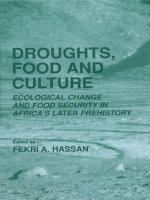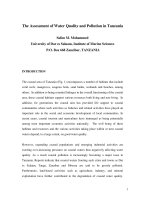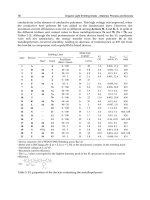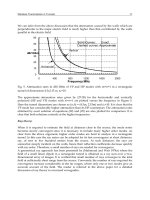Nature of Science: Conservation and Native Americans—2 pptx
Bạn đang xem bản rút gọn của tài liệu. Xem và tải ngay bản đầy đủ của tài liệu tại đây (22.45 MB, 366 trang )
DROUGHTS, FOOD
AND CULTURE
This page intentionally left blank
DROUGHTS, FOOD
AND CULTURE
Ecological Change and Food
Security in Africa’s Later Prehistory
Edited by
Fekri A. Hassan
University College London
London, England
KLUWER ACADEMIC PUBLISHERS
NEW YORK, BOSTON, DORDRECHT, LONDON, MOSCOW
eBook ISBN: 0-306-47547-2
Print ISBN: 0-306-46755-0
©2002 Kluwer Academic Publishers
New York, Boston, Dordrecht, London, Moscow
Print ©2002 Kluwer Academic/Plenum Publishers
All rights reserved
No part of this eBook may be reproduced or transmitted in any form or by any means, electronic,
mechanical, recording, or otherwise, without written consent from the Publisher
Created in the United States of America
Visit Kluwer Online at:
and Kluwer's eBookstore at:
New York
CONTRIBUTORS
R. Abu-Zied
,
Southampton Oceanography Centre, Southampton, SO14 3ZH, UK.
Hala N. Barakat
,
Cairo University Herbarium, Faculty of Science, Cairo University,
Giza, Egypt.
Barbara E. Barich
,
Dipartimento di Scienze Storiche, Archeologiche e
Antropologiche dell’Antichità, University of Rome “La Sapienza”, Via Palestro
63, 00185 Rome, Italy.
R. Bonnefille
,
CNRS, CEREGE, bp 80, 13545, Aix-en-Provence, Cedex 04, France.
Peter Breunig
,
Johann Wolfgang Goethe-Universität Frankfurt am Main, Seminar
für Vor- und Frühgeschichte, Archäologie und Archäobotanik Afrikas,
Grüneburgplatz 1, D - 60323 Frankfurt am Main, Germany.
H. Brinkhuis
,
Laboratory of Palynology and Paleobotany, Utrecht University, The
Netherlands.
Ann Butler
,
Institute of Archaeology, University College London, 31-34 Gordon
Square, London, WC1 0PY, UK.
J. Casford
,
Southampton Oceanography Centre, Southampton, SO14 3ZH, UK.
Mauro Cremaschi
,
CNR Centro di Geodinamica Alpina e Quaternaria, Dipartimento
di Scienze della Terra, University of Milan, Italy.
I. Croudace
,
Southampton Oceanography Centre, Southampton, SO14 3ZH, UK.
Savino di Lernia
,
Centro Interuniversitario di Ricerca sulle Civiltà e l'Ambiente del
Sahara Antico, University of Rome “La Sapienza”, Via Palestro 63, 00185 Rome,
Italy.
Achilles Gautier
,
Laboratorium voor Paleontologie, Vakgroep Geologie en
Bodemkunde, Universiteit Gent, Krijgslaan 281/S8, B-9000 Gent, Belgium.
Fekri A. Hassan
,
Institute of Archaeology, University College London, 31-34
Gordon Square, London, WC1 0PY, UK.
Stan Hendrickx
,
Katholieke Universiteit Leuven, Laboratorium voor Prehistoire,
Redingenstraat 16 bis, B-3000 Leuven, Belgium.
F. J. Jorissen
,
Department of Oceanography and Geology, University Bordeaux I,
CNRS URA 197, France.
J. Kallmeyer
,
Department of Earth Sciences, Bremen University, Germany.
D. Mercone
,
Southampton Oceanography Centre, Southampton, SO14 3ZH, UK.
M. U. Mohammed
,
Department of Geology and Geophysics, Addis Ababa
University, c/o P.O.Box 3434, Addis Ababa, Ethiopia.
Katharina Neumann
,
Johann Wolfgang Goethe-Universität Frankfurt am Main,
Seminar für Vor- und Frühgeschichte, Archäologie und Archäobotanik Afrikas,
Grüneburgplatz 1, D - 60323 Frankfurt am Main, Germany.
v
vi
Contributors
E. J. Rohling
,
School of Ocean and Earth Science, Southampton University,
Southampton Oceanography Centre, Waterfront Campus, European Way,
Southampton, SO14 3ZH, UK.
Martine Rossignol-Strick
,
Laboratoire de Paléobiologie et Palynologie, Boite 106,
Université Pierre et Marie Curie, 4 Place Jussieu, 75252 Paris cedex 05, France.
M. Adebisi Sowunmi
,
Department of Archaeology and Anthropology, University of
Ibadan, U. I. P. O. Box 20204, Ibadan, Nigeria.
J. Thomson
,
Southampton Oceanography Centre, Southampton, SO14 3ZH, UK.
Wim Van Neer
,
IUAP, Royal Museum of Central Africa, 3080 Tervuren, Belgium.
Robert Vernet
,
Département d’Histoire, Faculté des Lettres, BP 396, Nouakchott,
Mauritanie.
G. Wefer
,
Department of Earth Sciences, Bremen University, Germany.
PREFACE
Recent droughts in Africa and Europe have serious implications for food security and
grave consequences for local and international politics. The issues do not just concern
the plight of African peoples or Europe’s role in alleviating catastrophic conditions,
but also Europe’s own ecological future. Africa’s Sahel zone is one of the most
sensitive climatic regions in the world, and the events that gripped that region in the
1970s were the first indicators of a significant shift in global climatic conditions.
Deterioration of living standards in Africa due to adverse climatic conditions is also
likely to involve the world community in various dimensions.
With the realization that contemporary climatic events and their
consequences could not be properly interpreted without an adequate knowledge of
long-term climatic variability and associated cultural developments in Africa, a
workshop was organized, from 15 to 18 September 1998 in London (UK), on
‘Ecological Change and Food Security in Africa’s Later Prehistory’, with a generous
grant from the European Science Foundation. In addition to substantive contributions
to our knowledge of African prehistory, the workshop was also a venue to explore the
potentials for a comprehensive, integrated program of future research with the
following goals in mind:
(1)
(2)
(3)
(4)
to develop a common strategy for documenting and interpreting local
responses to global ecological events and their influence on intercultural
contacts
;
to forge available data into a coherent ecological-cultural framework;
to explore means by which data can be processed in a dynamic model that
can be used for interpretation of the long-term consequences of ecological
events; and
to establish a data bank of ecological and archaeological data to assist
researchers and policy makers in assessing long-term ecological processes.
The workshop was thus an opportunity to overcome the limitations imposed
by the lack of coordination among research teams working in Africa and the absence
of a concerted strategy of archaeological inquiry on a continental scale. Although the
scope of this volume was limited by design and by practical necessities to a select
group of eminent archaeologists and palaeoclimatologists, it is hoped that future
meetings will integrate the results from this workshop within other regional contexts
and specific topical domains.
vii
viii
Preface
It is also hoped that this volume will alert archaeologists to the effects of
severe, abrupt, and closely-spaced climatic events on the course of cultural
developments. Such events, which are now becoming quite evident thanks to high-
resolution palaeoclimatic data, are likely to cause significant ruptures in the cultural
fabric of societies on various scales. Some of the events discussed in this volume have
proven to be of a global, trans-continental nature. This global interconnection is due
to the response of the shift of the Intertropical Convergence Zone across an area that
extends from parts of South and Mesoamerica to China. The contributions in this
volume should be seen as parts of a whole, which is in turn a part of trans-continental
cultural developments in response to climatic crises that punctuated the millennial
change in climate. Archaeologists stand to gain a deeper understanding of the past by
focusing on specific climatic events that set in motion cultural responses, that in turn
have cultural consequence under similar or pre-existing long-term climatic conditions.
It would be a grave error to resurrect the ghost of environmental determinism
in order to undermine current efforts to clarify the intricate link between climate and
society. It is now abundantly clear that the impact of any climatic change is mediated
by human perceptions and social action, and that many cultural developments are
predicated upon previous cultural choices and norms. Cultural developments are not
to be explained in terms of a single paramount cultural mechanism, such as diffusion
or the banal “evolution”, but in terms of a model of cultural innovations (that may
range from prayers to migration) that are maintained or rejected by the local
community, that may or may not be adopted (often with significant modifications) by
neighboring groups, and that may or may not survive from one generation to the next.
In this volume, the appearance of cattle keeping in Africa and its impact on
African societies in different ecological contexts, in response to adverse abrupt
climatic crises, reveals the poverty of deterministic thinking, the shortcomings of
simplistic diffusionary models, and the deficiency of linear evolutionary models. The
origins and dispersal of cattle keeping in Africa, by contrast, reveal that societies
chose from a set of probable responses, that they accepted, assimilated and modified
innovations (local or borrowed) within the context of their field of knowledge and
action, governed by norms, mores, and organizational parameters. The emergence of
cattle pastoralism, for example, in Central, West and East Africa were independent
local responses taking advantage of local ecological conditions and within a strategy
that maintained earlier traditions. The disparity between Egypt and other neighboring
African countries was a result of a different timing of events, different ecological
settings (the Lower Nile as a significant factor), and the cultural geography of Egypt
within North Africa and in proximity to Southwest Asia. Travelling on different
tracks in response to the same climatic events, different groups responded, at a later
time, to the next climatic event in a very different manner from before. Developments
in a cultural region may also have an impact on neighboring regions.
A more profound understanding of how societies dealt with climatic change
in the past is one of the means by which we can cope with our changing climate
today. This volume not only highlights the importance of detecting the timing and
Preface
ix
severity of past abrupt climatic events, but also the role of archaeological
investigations in teasing out such events and clarifying their impact on human
societies. The palaeoclimatological community is also now challenged to explain the
causes of such abrupt events and to provide measures of climatic change that are
significant in the realm of human affairs.
This volume is thus an attempt to bring archaeology within the domain of
contemporary human affairs, and to forge a new methodology for coping with
environmental problems from an archaeological perspective.
Participants in the London workshop included: Dr. Hala Barakat (Cairo),
Prof. Barbara Barich (Rome), Mr. Obare Bogado (Benin), Prof. Peter Breunig
(Frankfurt), Dr. Ann Butler (London), Dr. R. Chedadi (Marseilles), Prof. Mauro
Cremaschi (Milan), Dr. Savino di Lernia (Rome), Dr. Françoise Gasse (Aix-en-
Provence), Prof. Achilles Gautier (Gent), Dr. Stan Hendrickx (Brussels), Dr. Steve
Juggins (Newcastle-Upon-Tyne), Ms. Dagmar Kleinsgutl (London/Vienna), Dr.
Henry Lamb (Aberstwyth, Wales), Dr. Kevin MacDonald (London), Dr. James
McGlade (London), Dr. Katharina Neumann (Frankfurt), Dr. François Paris
(Paris/Cairo), Dr. E. J. Rohling (Southampton), Dr. Martine Rossignol-Strick (Paris),
Prof. Paul Sinclair (Uppsala), Prof. Adebisi Sowunmi (Ibadan, Nigeria), Prof. A. C.
Stevenson (Newcastle-Upon-Tyne), Dr. Mohammed Umer (Addis Ababa), Prof. T. H.
van Andel (Cambridge), Dr. Wim Van Neer (Tervuren), and Dr. Robert Vernet
(Nouakchott, Mauritania). Mrs. Marianne Yagoubi, represented the European Science
Foundation at the meeting.
I am most thankful to all who attended for the lively and stimulating
discussions that have opened up new vistas for investigation and new possibilities for
cooperation between scholars from different regions and disciplines. I am also
particularly grateful to those who contributed to this volume. The workshop was held
at the Institute of Archaeology, University College London, and I am indebted to
Prof. Peter Ucko, Director of the Institute, for making the facilities of the Institute
available for the workshop. The workshop has signaled for me a new direction in
African archaeology, with theoretical implications for archaeology as a whole, and I
wish to thank the European Science Foundation for its support of that event. Partial
financial support through Prof. Paul Sinclair is also gratefully acknowledged. I wish
also to acknowledge logistic support by Dr. Hala Barakat, Geoffrey Tassie, Joanne
Rowland, Dagmar Kleinsgutl, and Janet Picton. Special thanks go to Julie Wilson
who copy edited this work and prepared it for publication.
Cherish the land from the spoiling drought, from the raging wind, the
dust-laden storm and the beating rain.
From a treatise by al-Maghali to the king of Kano in the
century (in Isichei, 1997, p. 20)
CONTENTS
List of Figures
List of Tables
1.
2.
Introduction
F. A. Hassan
Palaeoclimate, Food and Culture Change in Africa: An Overview
Section I: Climatic Change
3.
4.
5.
6.
7.
Rapid Holocene Climate Changes in the Eastern Mediterranean
Climate During the Late Holocene in the Sahara and the Sahel: Evolution
and Consequences on Human Settlement
F. A. Hassan
E. J. Rohling, J. Casford, R. Abu-Zied, S. Cooke,
D. Mercone, J. Thomson, 1. Croudace, F. J.
Jorissen, H. Brinkhuis, J. Kallmeyer and G. Wefer
R. Vernet
Late Pleistocene and Holocene Climatic Changes in the Central Sahara:
The Case Study of the Southwestern Fezzan, Libya
M. Cremaschi
Late Holocene Climatic Fluctuations and Historical Records of Famine
in Ethiopia
M. U. Mohammed and R. Bonnefille
Environmental and Human Responses to Climatic Events in West and
West Central Africa During the Late Holocene
M. A. Sowunmi
Section II: Plant Cultivation
Regional Pathways to Agriculture in Northeast Africa
H. N. Barakat
8.
9.
From Hunters and Gatherers to Food Producers: New Archaeological
and Archaeobotanical Evidence from the West African Sahel
xvii
1
11
27
35
47
65
83
95
105
111
123
xi
xiii
xii
Contents
P. Breunig and K. Neumann
10.
11.
Holocene Climatic Changes in the Eastern Mediterranean and the Spread
of Food Production from Southwest Asia to Egypt
M. Rossignol-Strick
Sustainable Agriculture in a Harsh Environment: An Ethiopian
Perspective
A. Butler
Section III: Pastoralism
12.
13.
14.
15.
16.
The Evidence for the Earliest Livestock in North Africa: Or Adventures
with Large Bovids, Ovicaprids, Dogs and Pigs
A. Gautier
Cultural Responses to Climatic Changes in North Africa: Beginning and
Spread of Pastoralism in the Sahara
B. E. Barich
Dry Climatic Events and Cultural Trajectories: Adjusting Middle
Holocene Pastoral Economy of the Libyan Sahara
S. di Lernia
Food Security in Western and Central Africa During the Late Holocene:
The Role of Domestic Stock Keeping, Hunting and Fishing
W. Van Neer
Bovines in Egyptian Predynastic and Early Dynastic Iconography
S. Hendrickx
Conclusion
17.
Ecological Changes and Food Security in the Later Prehistory of North
Africa: Looking Forward
F. A. Hassan
Index
157
171
189
195
209
225
251
275
321
335
LIST OF FIGURES
2.1
2.2
3.1
3.2
3.3
4.1
4.2
4.3
4.4
4.5
5.1
5.2
5.3
5.4
5.5
5.6
5.7
5.8
5.9
5.10
5.11
6.1
Distribution of earliest cattle in Africa
Draft sketch of Holocene climatic variability in Africa
Warm versus cold planktonic foraminiferal percentages for cores IN68-
9, LC21, and LC31, plotted against core-depth in cm as corrected
for thicknesses of ash-layers and turbidites
Key benthic foraminiferal species in cores LC31 and LC21
Warm-cold record and stable oxygen isotope record (G. ruber) for
LC21, versus age in calibrated yrs BP
Evolution of the number of palaeoenvironmental age determinations in
the Sahara
Radiocarbon and animal occurrences in the Holocene Sahara
Diachronic evolution of economic stock species in Kerma (Sudan):
bovines and ovicaprides
Human occupation in the south Sahara and north Sahel at the end of the
Neolithic and at the beginning of history, according to radiocarbon
determinations (494 dates)
Palaeoenvironments and human occupation during the Holocene in the
southwest Sahara
Location of the area studied in Chapter 5
The stratigraphic sequence of Uan Afuda
The stratigraphic sequence of the site MT21 in the Messak Sattafet
U/Th dates of the travertine and anthropogenic deposits at site 96/50,
Wadi Tanshalt
The first cycle of the rock shelter’s fill: the Uan Tabu sequence
The second cycle of the rock shelter’s fill: the stratigraphic sequence of
Uan Muhuggiag
Schematic stratigraphic sequence of a lacustrine basin in the Murzuq
Edeyen
Schematic stratigraphic sequence of a lacustrine basin in the Erg Uan
Kasa
Stratigraphy of a phytogenic dune at the site TAH4 along Wadi
Tanezzuft at Tahala
The climate changes as reconstructed by geological proxy
Radiocarbon age determinations discussed in Chapter 5
Location map of the core sites discussed in Chapter 6
15
19
36
38
41
48
53
56
58
59
66
67
68
69
71
72
74
75
76
77
79
84
xiii
xiv
List of figures
6.2a
6.2b
6.3a
6.3b
7.1
8.1
8.2
9.1
9.2
9.3
9.4
9.5
9.6
9.7
9.8
9.9
9.10
9.11
9.12
9.13
10.1
11.1
11.2
11.3
12.1
13.1
13.2
Pollen diagram from the Orgoba 4 core (O4), 3880 m, Bale
Mountains, Ethiopia, arboreal pollen taxa
Pollen diagram from the Orgoba 4 core (O4), 3880 m, Bale Mountains,
Ethiopia, non-arboreal pollen taxa
Pollen diagram from the Dega Sala core (D1), 3600 m, Arsi,
Mountains, Ethiopia. Arboreal (AP) pollen taxa
Pollen diagram from the Dega Sala core (D1), 3600 m, Arsi Mountains,
Ethiopia. Non-arboreal pollen taxa
Map of West and West Central Africa showing the vegetation zones of
the Guineo-Congolian region and pollen core sites of Chapter
7
Location map showing sites mentioned in Chapter 8
Palaeovegetation map of Nabta area ca. 8000 yr bp
Study areas under consideration in Chapter 9
Map of northern Burkina Faso with major excavation sites
Radiocarbon chronology of the later prehistory of the Sahel Zone of
Burkina Faso based on calibrated dates
Cultural material from different Final Stone Age dune sites in the Sahel
Zone of Burkina Faso
Map of the Chad Basin of Northeast Nigeria with archaeological sites
Radiocarbon chronology of the Holocene prehistory of Northeast
Nigeria
Distribution of firki mounds and of sites of the Gajiganna Culture,
Northeast Nigeria (ca. 1800 cal BC – 800 cal BC) divided into
pastoral (phase I) and agropastoral (phase II) stages
Pottery of phases I and II of the Gajiganna Culture
Economic and cultural appearance of the Gajiganna Culture
Gajiganna: Percentage values of plant impressions in potsherds from
phase I to phase IIc
Stone artifacts of the Gajiganna Culture
Bone tools of the Gajiganna Culture
Map of sites with Gajiganna related pottery
The Eastern Mediterranean (Levantine Basin) Ghab Valley and Lake
Hula: pollen records, Merimde and the Fayum: first agricultural
sites in Africa
Minimum tillage: 2-oxen scratch plow, leaving stones on the fields,
Adi Ainawalid, Tigray
Treeless landscape with stone terracing near Adi Ainawalid, Tigray
Sorghum crop with mixed varieties. Adi Bakel, Tigray
Location map of sites in Egypt and Sudan referred to in Chapter 12
Map of the Libyan Sahara
Pottery with rocker impressions from Uan Muhuggiag, Tadrart Acacus,
Libya
86
87
90
91
96
112
114
124
125
127
130
133
134
136
139
141
142
144
145
147
159
174
175
177
199
211
214
List of figures
xv
13.3
13.4
14.1
14.2
14.3
14.4
14.5
14.6
14.7
14.8
14.9
14.10
14.11
14.12
15.1
15.2
15.3
16.1
16.2
16.3
16.4
Map of the Egyptian Western Desert, showing directions of the
dispersal of domestic cattle
Mid-late Holocene cultural sequence in the Sahara and the Nile
Valley
Recent production of the main alimentary sources in North Africa
The area licensed to the Italo-Libyan Joint Mission
Dating of Holocene archaeological sites in the Acacus and
surroundings, in radiocarbon uncalibrated years before present
A Middle Pastoral site in the erg Uan Kasa. The site 94/63 shows an
articulated intrasite organization and evidence of re-occupations
A model of the Middle Pastoral settlement pattern in the Acacus and
surroundings, based on a seasonal vertical transhumance between
lowlands and mountains
The cranium of the mummified infant from Uan Muhuggiag
A rock shelter in the Acacus used as sheep/goat dwelling during the
Late Pastoral
A model of the Late Pastoral settlement pattern of nomadic groups in
the Acacus and surroundings, characterized by a high mobility and
large-scale movements
Examples of ‘exotic’ tools found in Late Pastoral sites
The settlement pattern of nomadic and semi-nomadic pastoral groups in
the area of the Acacus Mountains at the beginning of the century
The semi-sedentary groups of the Late Pastoral in the Wadi Tanezzuft
Valley. Sites feature a high density and are concentrated near the
paleo-oasis of Tahala
Circular tumuli in the eastern slopes of the Acacus Mountain, facing
the erg Uan Kasa
Map of the major localities mentioned in Chapter 15 for West and
Central Africa
Relative importance of fishing, hunting and herding on sites in the
region considered in Chapter 15 (calculated on the basis of number
of identified specimens)
Dietary contribution of fishing, hunting and herding on sites in the
considered region (calculated on the basis of number of identified
specimens multiplied by an average total weight)
‘Double bull’s head amulets’. Abydos (?), formerly Hilton-Price
collection (Brussels E.3381a-c)
Bull’s leg amulet. Provenance not recorded, formerly MacGregor
collection (Brussels E.6154)
Figurative flint. Nagada, ‘royal tomb’, formerly MacGregor collection
(Brussels E.6185a)
‘Bull’s head’ amulet. Provenance not recorded (Brussels E.2335)
216
218
226
227
230
233
234
236
239
241
242
243
244
245
252
266
268
281
282
284
286
xvi
List of figures
16.5
16.6
16.7
16.8
16.9
16.10
16.11
16.12
16.13
16.14
16.15
‘Bull’s head’ amulet, late type. Provenance not recorded, formerly
Scheurleer collection (Brussels E.7126)
Palette in the shape of bovid with bird amulet as leg. Provenance not
recorded (Brussels E.4992)
Bird amulet. Provenance not recorded (Brussels E.2179)
‘Pelta’ palette with two bird heads. Provenance not recorded (Brussels
E.421)
‘Pelta’ palette with one bird head. Provenance not recorded (Brussels
E.422)
Rhomboidal palette decorated with double (?) bull’s head. Provenance
not recorded (Brussels E.2182)
Greywacke needle. Provenance not recorded (Brussels E.2187)
Palette with simplified Bat emblem. Provenance not recorded,
Scheurleer collection (Brussels E.7129)
Amulets: a. Provenance not recorded (Brussels E.2882); b. Provenance
not recorded (Brussels E.2880); c. Ballas-Zawaida (bought),
formerly MacGregor collection (Brussels E.6188b)
Amulets: a. Provenance not recorded (Brussels E.2881); b. Provenance
not recorded, formerly MacGregor collection (Brussels E.6188e); c.
Ballas-Zawaida (bought), formerly MacGregor collection (Brussels
E.6188c); d. Unidentified Petrie excavation (Brussels E.1231)
‘Double bird head’ palette. Provenance not recorded (Brussels E.2886)
286
290
290
291
291
293
294
294
295
296
297
LIST OF TABLES
1.1
1.2
2.1
3.1
6.1
6.2
6.3
7.1
7.2
8.1
9.1
9.2
11.1
12.1
13.1
14.1
15.1
17.1
Frequency of climatic events of different duration during the Holocene
of Africa
Conversion table of radiocarbon age estimates
Calibrated radiocarbon age determinations of oldest domestic or
putatively domestic cattle in Africa
Uncorrected radiocarbon ages (bp) for biozonal boundaries in Central
Mediterranean cores studied by Jorissen et al. (1993)
Uncalibrated dates in yr bp of the studied cores (D1 and O4)
Synchronous pollen events in cores Orgoba 4, Bale Mountains and
Dega Sala 1, Arsi Mountains
Climatic phases inferred from the sunchronous pollen zones of cores
Orgoba 4, Bale Mountains and Dega Sala 1, Arsi Mountains
Summary of late Holocene environmental changes in West and West
Central Africa
Some of the uses of the oil palm tree
Presence/absence of a variety of grass types at Nabta, Hidden Valley
and Abu Ballas
Radiocarbon dates from archaeological sites in the Sahel zone of
Burkina Faso
Radiocarbon dates of the Gajiganna complex in the Chad Basin of
Northeast Nigeria
Strategies for sustainable subsistence at Adi Ainwalid, Tigray
Some Latin labels applied to animal domesticates
Libya: synthetic radiocarbon chronology of deposits at Uan
Muhuggiag
Domestic animals from Holocene archaeological sites in the Acacus
and surroundings
Radiocarbon dates discussed in Chapter 15
Chronology of climatic and cultural events discussed in this work
5
8
14
39
85
88
89
98
102
115
128
138
183
197
212
235
254
322
xvii
This page intentionally left blank
DROUGHTS, FOOD
AND CULTURE
This page intentionally left blank
1
INTRODUCTION
F. A. Hassan
This book is an attempt to situate archaeology within the domain of contemporary
human affairs, and to forge a new methodology for coping with environmental
problems from an archaeological perspective. From this perspective, the papers
included in this volume highlight the aspects of the historical relationships
between people and climatic change that are potentially useful in coping with
current climatic fluctuations. Those aspects include:
(1)
(2)
(3)
(4)
The ubiquity and prominence of abrupt, severe climatic events as
triggers of human responses.
The importance of regional variability in response to global climatic
phenomena as a result of historical antecedents and local ecological
settings. The response of plants, animals, and water resources to climatic
events are particularly significant as a stimulus to human actions.
The indeterminacy of human responses and the importance of
environmental perception and decision making, given the options and
opportunities available to communities at times of repeated harsh
weather conditions. These responses may include: population dispersal,
modifications of social organization, technological or economic
innovations, and initiation of ritual, religious, or ideological practices.
The role of population movements and dispersal, demographic flux,
information networks, exchanges of food and goods and, in certain
contexts, trade, make it necessary to consider major cultural
transformations in terms of trans-regional and long-distance interactions.
Within the scope of contemporary archaeology, as represented by
several contributions in this volume from current archaeological projects in
Africa, the interactions between culture and the environment are not a matter of
polemical debate, but of continued research to improve our understanding of the
nature of that relationship. In this context, the investigation of cultural-
environmental relationships on the Colorado Plateau (Gumerman, 1988) is
particularly useful because of its theoretical perspicacity and methodological
rigor. The study, which focused on the impact of changing climate for the 600-
1300 AD interval, also a period of special interest in Africa’s climatic history,
concluded that responses to frequent droughts included:
(1)
(2)
abandonment of settlements;
movement to lowlands; and
1
2
F. A. Hassan
(3)
initiation of intensified subsistence practices.
The study also revealed a direct correlation between settlement behavior
and interaction among groups, and spatial variability in precipitation.
Although there are archaeologists who would rather not concern
themselves with environmental issues, not to mention those who think that
cultures are entirely arbitrary subjective constructs, they might have found it
disturbing that water had to be carried by trucks to fill the water reservoirs in
England in 1995.
The impact of droughts since the 1970s on vegetation, food production
and water resources in the African Sahel and all over the world, from China to
Brazil, including Spain and the UK, for example, clearly demonstrate that a
change in climate could have had an impact on cultures in the past. The current
debate on global warming, its causes and consequences, has also focused both
scholarly investigations and public attention on the relationship between climate
change and the future of our food security and political stability. In the 1980s, it
was estimated that roughly 30 billion dollars are lost annually due to changes in
weather (Riebsame, 1989). Perhaps more significant than economic loss is the
degradation of human life and the proliferation of violent conflict. Homer-Dixon,
Boutwell, and Rathjens (1993, p. 38), who co-directed a project on environmental
change and acute conflict, concluded that “scarcities of renewable resources are
already contributing to violent conflicts in many parts of the developing world”.
These conflicts may foreshadow a surge of similar violence in coming decades,
particularly in poor countries, where shortages of water, forests, and especially
fertile land, coupled with rapidly expanding populations, already cause great
hardship.
Within a few decades, the output from palaeoclimatic investigations has
radically modified our traditional concepts of climate and climatic change.
Archaeological investigations, which have pioneered the study of the relationship
between climatic-environmental fluctuations and cultural change, are also
beginning to clarify the complex connections that link cultures to their
environmental setting. Gone is the naive presumption that climate is the prime
mover of change, and gone also is the simplistic correlation of long-term climatic
periods with significant cultural innovations, and the belief that such correlations
reflect a deterministic, causal link; with climate as a cause and cultural
developments as an effect (Sprout and Sprout, 1965).
The dynamic interactions between climate and culture are still far from
clear. We are now in need of a genuine collaboration of archaeologists,
palaeoclimatologists and palaeoecologists within the framework of a research
program with explicit foci of joint investigations. Such a program of research will
not only provide us with much needed basic information (for example, high
resolution chronology of climatic events), but will also bring about a new
perspective on the methodology and theoretical aspects of the relationships
between climate and culture.
One of the fundamental notions that we may consider is that of the
mechanisms by which climatic events may cause a cultural response (Kates,
1985). Perhaps central to these mechanisms is the way by which a climatic event
influences resources of economic, social, or ideological relevance to a group of
Introduction
3
people. For example, a farming community may react to a climatic event that may
influence the growing season, the area irrigated, or ground moisture. Pastoralists
may react to changes in the location and permanency of water holes and the
quality and extent of pastures. Inland populations may not worry about coastal
changes as a result of a sea transgression, but coastal groups depending on fishing
and collecting mussels may respond effectively to the changing circumstances.
It is also perhaps prudent not to ignore the mechanisms by which an
environmental change is perceived (Sonnenfeld, 1972; Whyte, 1985), or the chain
that leads from the perception of environmental change to making certain
decisions (Craik, 1972) and then implementing them. It would appear that
environmental perception will depend on the rapidity of a change, its intensity
and its frequency (Hassan, 2000). Events that happen in a person’s lifetime (or
that of his/her immediate kin and social group), ranging from those that may
cause a deterioration in the quality of life to life-threatening famines or disasters,
are most likely to be perceived. Measures to alleviate, side-step or overcome such
events are likely to be adopted, or not, depending on the social milieu of
innovation and the criteria set by society for acceptable conduct (for example,
remedying food shortages through cannibalism or infanticide, or switching from a
meat-based diet to the ingestion of cereal grains). In general, food shortages may
be met by: (1) modifying diet by exploiting less desirable resources to expand the
width of the food niche; (2) developing innovative technological, economic,
social or ideological means to enhance the productivity or quality of new or pre-
existing resources (for example, developing the plow to replace the hoe, using
grinding stones, engaging in food exchange networks, or changing the size and/or
organization of the labor force, instituting or abandoning certain beliefs
concerning the harvesting or consumption of certain resources); (3) re-organizing
the demographic regime through changes in local densities, demographic flux,
emigration, seasonal aggregation/dispersal, altering the dependency ratio, and
manipulating fertility or mortality practices (from abortion to abstinence). Among
the responses to drought years in selected villages within the arid zone of India
(where a normal year is characterized by 377 mm of rain over 21 days compared
with 159 mm over 8 days), recorded by Riebsame (1989, p. 14) were:
(1)
(2)
(3)
(4)
(5)
(6)
collecting weeds as fodder;
harvesting field borders for fodder;
harvesting premature crops;
harvesting crop by-products;
more weeding; and
lopping trees for fodder.
In Tanzania, reactions to droughts by at least fifty per cent of farmers in
the Usambara mountains included (Riebsame, 1989, p. 14):
(1)
(2)
(3)
(4)
(5)
selling cattle to buy food;
storing more than one season’s food when crop is good;
moving;
asking for help from friends and relatives;
weeding plots;
4
F. A. Hassan
(6)
(7)
(8)
(9)
(10)
not planting when rain is not enough;
planting drought resistant crops;
paying for a rain maker;
praying; and
irrigation.
The likelihood of the sustainability, collapse or expansion of a certain
cultural mode depends thus not only on the rapidity, intensity and frequency of
climatic-environmental signals, but also on the elements and structural
organization of the particular culture involved. In general, we may also make a
distinction between cultures with different organizational structures. Such
structures are, in essence, modes of management, and vary from those where
decision making is left to individual choice to the other extreme, where decision-
making and action are monopolized by an elite. Such an elite, who are common in
complex state societies, acting for their own good or that of the larger society in
as much as it enhances their own, may take decisions that may be harmful to
certain local communities or individuals. It may be beneficial for the common
good, if by enhancing innovative developments it may succeed in sustaining a
quality of life or a group size that otherwise would not be possible. However, the
elite may make and implement decisions that may be short-sighted or partial to
their interests. In addition, they may sustain a population size and a high living
standard that places society at greater risk of climatic-environmental anomalies.
Moreover, such an elite institute ideologies and practices (for example, ideologies
in favor of large farming families, acquisition of resources by force, or
consumption of luxury goods) that may increase the vulnerability of the cultural
regime to environmental disasters. In fact, the success of such cultures may lead
to environmental stress or adverse environmental consequences (for example, as a
result of deforestation, overgrazing or monocropping).
The ability to monitor and predict climatic change is predicated upon the
time scale of human perception and the scale of environmental change. The
earliest civilizations have used writing to preserve historical knowledge of
astronomical and environmental events (for example, droughts or Nile flood
levels). Before that, oral traditions constituted the repository of environmental
knowledge. Until recently, when long-term records of climatic history extending
as far back as millions of years became known, with great details of events over
the last 100,000 years, perception of environmental events was extremely limited
and patchy. The scale of human perception was incapable of construing climatic
history in terms of events that differed in scale from variations over intervals of a
few millennia, a few hundreds of years or a few decades, and those less than two
decades (for time-scale and environmental change, see Driver and Chapman,
1996).
Such millennial variations are suggested by recent palaeoclimatic
investigations of sea surface temperature (presented here by Rohling and
colleagues) and ice-rafted debris in the North Atlantic (Bond et al., 1997). From
my analysis of climatic variability during the post-glacial period from 13 kyr cal
BC to 1250 AD in Africa, I detect thirty events ranging in duration from a
millennium to a century (Table 1.1). Shorter events are masked by the lack of









